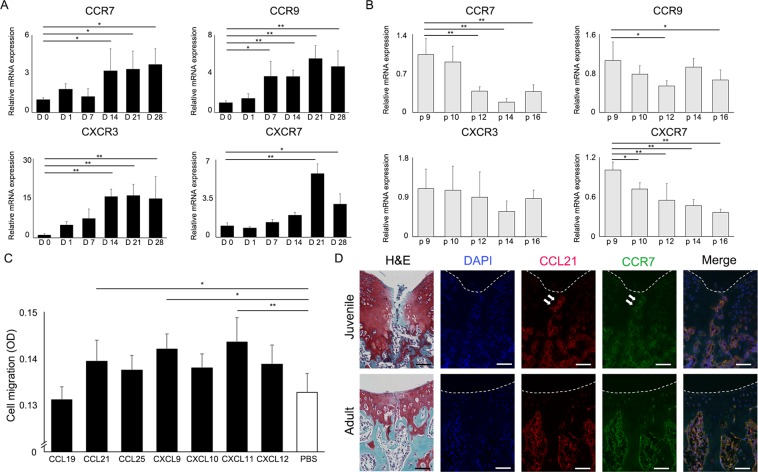Figure 1.
The CCL21/CCR7 axis was identified as a candidate target related to the cartilage repair mechanisms in juvenile animals. (A) Changes in the gene expression of chemokine receptors induced by chondrogenic differentiation. The mRNA expression patterns in cartilage differentiation (Day 0 to 28) were analysed (n = 3/group at each time point). All values are expressed as mean ± SD. *P < 0.05, **P < 0.01, significantly different compared to mRNA expression at D 0 (ANOVA followed by Tukey’s post hoc test). (B) Changes in the gene expression of chemokine receptors induced by long-term cultivation of MSCs. The mRNA expression patterns in long-term cultivation of MSCs in monolayer culture (passages 9 to 16) were analysed (n = 3/group at each time point). All values are expressed as mean ± SD. *P < 0.05, **P < 0.01, significantly different compared to mRNA expression of p 9 (ANOVA followed by Tukey’s post hoc test). (C) Cell migration assays were performed with the addition of the 7 chemokines corresponding to the receptors identified in the initial screening to the culture medium (n = 10/group). All values are expressed as mean ± SD. *P < 0.05, **P < 0.01, statistically significant (ANOVA followed by Tukey’s post hoc test). (D) CCL21 and CCR7 expression following osteochondral injury in WT mice (juvenile, upper row; adult, lower row). Representative images of immunohistochemistry for CCL21 (red) and CCR7 (green) in WT mice (juvenile, 3-week old; adult, 8-week old). CCL21, CCR7 were expressed at the injury sites of juvenile mice (white arrow). Scale bar: 50 µm.

